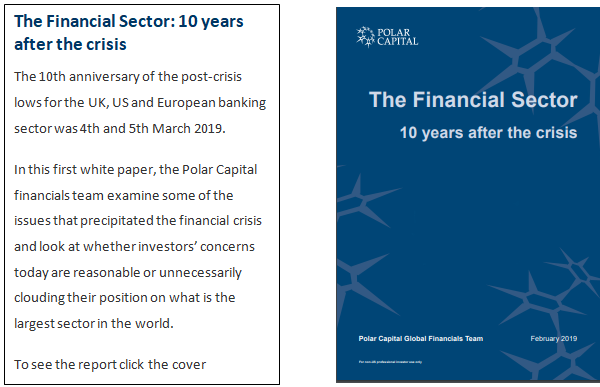Sep
2019
10 years after the bank lows – is it time to return to financials?
DIY Investor
10 September 2019
It is hard to believe it is more than 10 years since the banks reached their lowest point of the global financial crisis.
However, after a huge amount of work, led by regulators and legislators, the financial sector – banks included – is far stronger, more stable and therefore should be more attractive to investors today. So, what has changed? And is the current pessimism over-hyped or still valid?
The crisis led to a concerted effort by governments and regulators worldwide to ensure individual banks were run as financially stronger businesses in their own right, thanks to a dramatic tightening of regulations.
Subsequently, the banking sector entered an era of low inflation, historically low interest rates and relatively lacklustre economic growth, which resulted in shrinking profit margins for banks and low growth in loans to individuals or companies.
‘the financial sector – banks included – is far stronger, more stable and therefore should be more attractive to investors today’
Since 2015, US banks have been recovering with margins, and therefore profits, growing consistently in line with rising interest rates.
European banks have failed to recover, since interest rates have yet to rise at a similar rate, while closer to home UK banks have been held back by PPI claims and concerns around Brexit.
Risks will always remain in the banking system – a global recession, or much weaker inflation, would be as significant a headwind for the sector as it would for global stock markets – but the key opportunity today is that investors are hugely overestimating these risks.
Years of very little loan growth, much tougher regulation and stronger bank balance sheets all suggest a banking system that is well placed to weather a downturn. The amount of capital a bank is obliged to hold is now at multi-year highs.
‘all suggest a banking system that is well placed to weather a downturn’
Lloyd’s Bank, for example, has a Tier 1 capital ratio (the amount of capital a bank has to hold to compensate for the risk of individuals or companies defaulting on loans and, as far as the regulator is concerned, a measure of its financial strength) that is more than double its 2008 level.
Another change we have seen in the past decade is a huge shift to digital banking, with many commentators talking about the risk that the sector suffers in the same way as retailers have thanks to technology-led disruption, in this case from ‘fintech’ companies. But investors are underestimating banks’ structural positioning. Many of them are acquiring, or working with, these new digital providers and have the necessary technology spend to take on new entrants.
Equally, banking is not the same as retailing in that the former is a highly regulated service, which at its core provides security for people’s savings.
‘the regulatory advantage fintech has had over banking is slowly being eroded’
As a result, customer relationships tend to be more long term in nature. Furthermore, the regulatory advantage fintech has had over banking is slowly being eroded and we expect this to continue.
Ten years on, a duller, more boring banking sector is what makes the financial sector overall a much more attractive proposition today than it was.
In fact, the banking sector is far better placed than 10 years ago to weather any pressures it may face. It is perhaps natural, but investors are assuming the worst. Maybe we will have to go through another downturn for investors to finally believe that risks have reduced, and that any slowdown may well be the catalyst for the recovery in the sector. As John Maynard Keynes said:
‘When the facts change, I change my mind. What do you do, sir?’
Nick Brind and John Yakas
Co-Managers, Polar Capital Global Financials Trust
Disclaimer
All opinions and estimates in this report constitute the best judgement of Polar Capital as of the date hereof, but are subject to change without notice, and do not necessarily represent the views of Polar Capital. Polar Capital is not rendering legal or accounting advice through this material; readers should contact their legal and accounting professionals for such information. This is not a prospectus, offer, invitation or solicitation to buy or sell securities and is not intended to provide the sole basis for any evaluation of the securities or any other instruments, which may be discussed. This is not a financial promotion. This is not a personal recommendation and you should consider whether you can rely upon any opinion or statement contained in this document without seeking further advice tailored for your own circumstances. The law restricts distribution of this document in certain jurisdictions; therefore, persons into whose possession this document comes should inform themselves about and to observe, all applicable laws and regulations of any relevant jurisdiction.
An Introduction to the Trust
The Polar Capital Global Financial Trust was launched in July 2013 to provide investors with a lower-risk way of investing in the financials sector. In the video the co-managers, Nick Brind and John Yakas discuss the Trust and some of the opportunities within the sector.
Click here for more information



Leave a Reply
You must be logged in to post a comment.